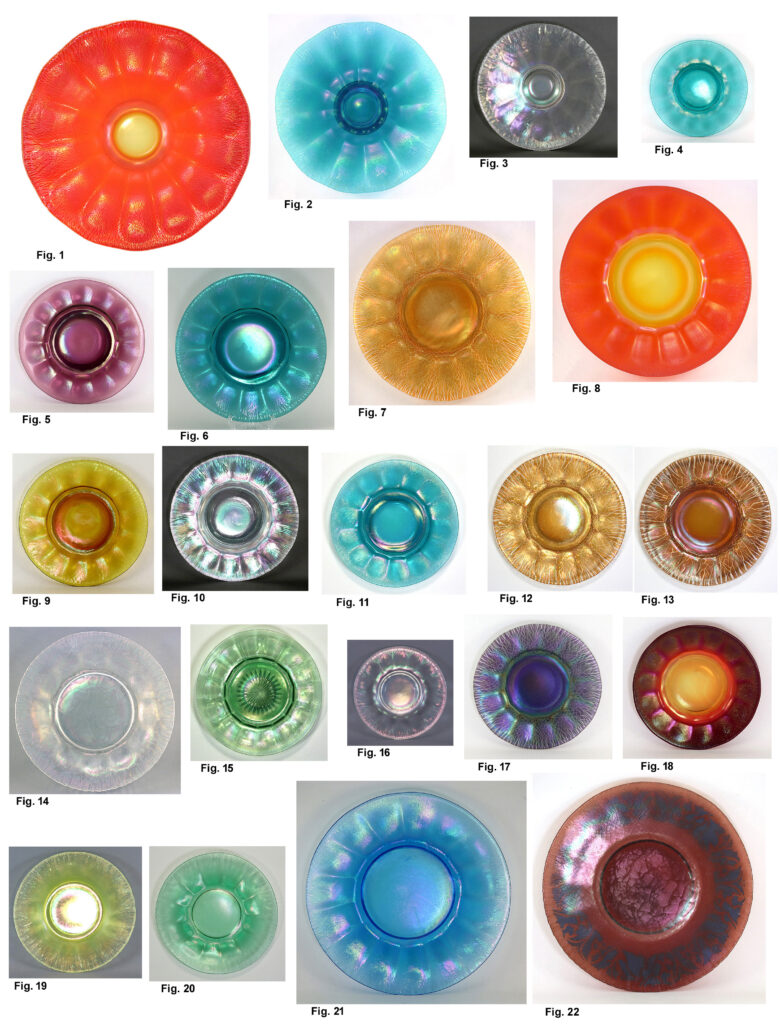
Wide Panel Plates Clarified….Hopefully!
Dave Shetlar, Director of Outreach (Stretch Glass Society)
Over the last couple of months, there have been numerous postings on Facebook and other sites where new owners or sellers have been trying to identify stretch glass plates that have what are generally called “wide panels” along the outside rim. In the past, these were all considered to be Imperial’s production, but we now know that the U.S. Glass factory that made stretch glass also made wide panel plates. Imperial’s wide panel plates are actually included in three, possibly four lines which makes things even more complicated. These plates will have 12 to 15 panels which separates them from some of the rayed plates made by Fenton, Northwood and Imperial.
First, let’s talk color. U.S. Glass plates come in crystal (Fig. 14), Topaz (Fig. 19), a green (Fig. 20) and a Celeste Blue-style blue (Fig. 21). The Imperial plates come in their “ice” stretch colors: Ruby Ice (Figs. 1, 8 & 18), Green Ice (often called teal)(Figs. 2, 4, 6, & 11), Iris Ice (Figs. 3 & 10), Blue Ice (often called smoke)(Fig. 17), Rose Ice (often called marigold)(Figs. 7, 12 & 13), Amethyst Ice (Fig. 5) and Amber Ice (Fig. 9). Notice that the only overlap in colors is the crystal! If you have a wide panel plate in red, marigold, smoke, teal, purple, amber or marigold, it’s Imperial! If you have one in topaz, green or blue, it’s U.S. Glass! That’s the simple part.
Second, let’s talk bases. All of the Imperial wide panel plates have “snap bases” (except for the little 6-inch wide mayonnaise plate (Fig. 14). Snap bases mean that there is a “foot rim” that was grasped in the jaws of a snap for finishing. All the U.S. Glass plates have ground bases, so they were “stuck up.” This means that the plate was heat stuck to a metal ring attached to a long rod for finishing. When finished, the rod was tapped to break off the plate which then went into the lehr for slowly lowering the temperature. After cooling, the slightly rough base was ground smooth. Thus, stuck up plates took more steps to finish than snapped plates.
So, there, you have two ways to separate Imperial and U.S. Glass wide panel plates! But, there’s more!
It appears that most of the wide panel plates were made from wide panel bowls. In the Imperial lines, all appear to have been placed in their #600 lines: #600 (often called Chesterfield where the panels are on the exterior, not the interior), #602 (mayonnaise), #640 (#645, #646, #647 & #648), & #6560 (#6565, #6567 & #6569). The #640 pieces have bases wider than their rims and the #6560 pieces have bases narrower than their rims. The #600 plates are about 6.5-inches in diameter, and they were made for the #600 sherbets. When you look closely, they will have the panels on the underside (Fig. 4). When flattened down, the #602 mayonnaise bowl becomes a 6-6.25-inch diameter plate (Fig. 14) which will hold the bowl. Both have ground bases. The #645 plates are the common 8-8.5-inch diameter plates (Figs. 5, 9-13, 17 & 18). In Rose Ice, the plates can have a fairly light marigold stretch effect (Fig. 12) to a dark brown effect (Fig. 13). The Blue Ice plates can also range from a very light grey to a dark bluish grey color (Fig. 17). The Ruby Ice pieces are almost always with an amberina effect (yellow in the center turning to red at the outside), but the red can be a pale red to a deep oxblood red. The Amethyst Ice (Fig. 5) and Amber Ice (Fig. 9) plates seem to be less common. Moving up in size, the #646 8-inch bowl made 10-10.5-inch wide plates (Fig. 6, Green Ice). The #647 bowls made 11-11.5-inch diameter plates (Fig. 7, Rose Ice), and the #648 bowls made 12.5-13-inch diameter plates (Fig. 8, Ruby Ice). In the #6560 line, the smallest bowl, #6565 made the 8-9-inch diameter plate (Fig. 3, Iris Ice), the next larger bowl, #6567 made a 11-12-inch plate (Fig. 2, Green Ice), and the large bowl, #6567 made a whopping 14-15-inch diameter plate (Fig. 1, Ruby Ice). Surprisingly, the big plates are most commonly seen in red stretch.
You may have noticed another green, wide panel plate (Fig. 15, 8-inch) which has always been a mystery to me. It has all the features of a true #600 (Chesterfield) piece as the panels are on the back side of the plate and a star pattern in the base. I’ve only seen a half dozen of these plates and the green color doesn’t match anything else that Imperial made and the color doesn’t match the U.S. Glass green either. For now, I’ll just consider it an aberrant piece most likely made by Imperial.
The most common U.S. Glass wide panel plates are the ones that can range from 7-inches in diameter (Fig. 19, Topaz) to 8-8.5-inches in diameter (Fig. 20, green). These are fairly obtainable in the U.S. Glass colors and some even have the Pomona or Cumula enamel decoration. The next size seems to range from 9.5 to 10.5 inches in diameter (Fig. 14, crystal) and the largest ones are 13-14.5-inches in diameter (Figs. 21, blue & 22, purple Pomona). I’ve seen the really large plates in crystal, blue and Topaz.
Reprinted with permission from the SGS (Stretch Glass Society) and the author.
